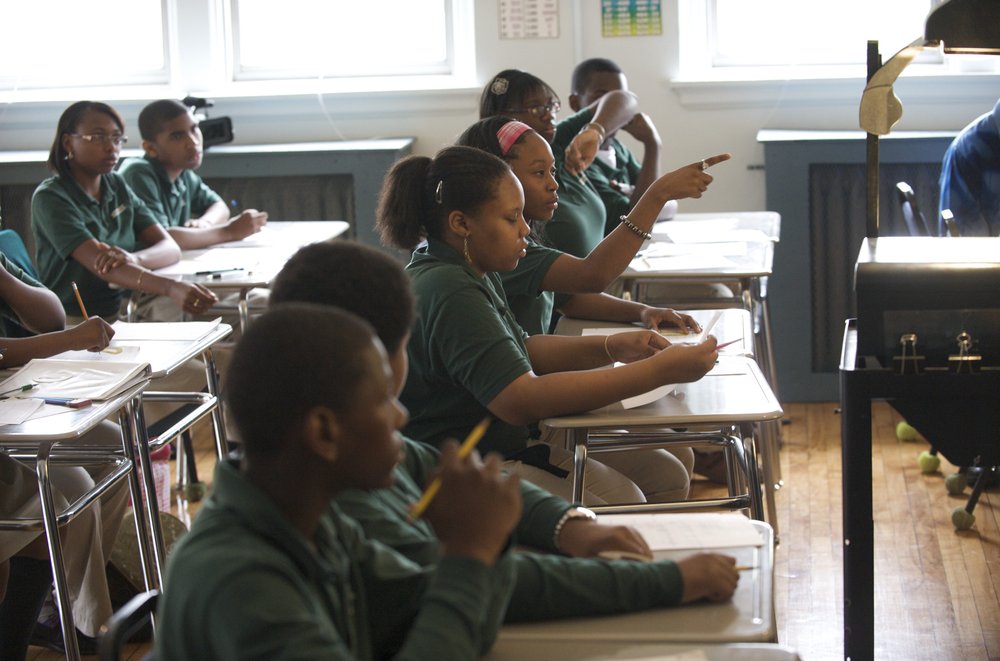Class size law could cost NYC nearly $2 billion per year, report finds
July 12, 2023, 4:05 p.m.
A new analysis by the Independent Budget Office found the city will need to hire as many as 17,700 teachers to comply with the new state law capping the headcount in classrooms.

A new law requiring smaller classes at New York City public schools could cost nearly $2 billion a year when fully implemented, according to a new analysis from the Independent Budget Office, underscoring the challenge the city will face in meeting the mandate.
Passage of the law by the state Legislature last year was a major victory for many parents and members of the United Federation of Teachers, who have pushed for lower class sizes for decades, citing positive impacts on student achievement and behavior. But city officials have said they do not know how they will find the funding, space and staff to meet the new requirements once the law is fully in effect.
The Independent Budget Office calculated that the city will eventually need to hire as many as 17,700 more teachers – which will cost between $1.6 billion and $1.9 billion per year.
“The IBO’s independent report backs up what Chancellor [David] Banks has been saying since this law was proposed – while we support lowering class sizes, this unfunded law will require very real, serious tradeoffs and hard choices,” said education department spokesperson Nathaniel Styer.
Under the law, kindergarten through third grade classes will be capped at 20 students, fourth through eighth grade classes will be capped at 23 students, and high school classes will be capped at 25 students. For comparison, kindergarten classes were previously capped at 25 students, first through sixth grade classes were capped at 32 or 33 students, middle school at 30 to 33 students, and high school at 34 students.
The new class size requirements must be phased in starting this fall, and will be rolled out at all the city’s schools over five years. Schools can be exempt from the class size limits if they are approved by the education department as well as the teachers' and principals' unions.
The city has said that 39% of classes already meet the new mandate, which is nearly the benchmark required by the law next school year, when 40% of classes are required to comply.
But later years pose a challenge.
The Independent Budget Office’s price tag for personnel needed to comply with the law is higher than one released by the education department this spring, which found that implementation was likely to eventually cost $1.3 billion per year for teachers – plus a total of $30 billion to $35 billion in capital costs for additional classrooms.
The education department’s operating budget is $31.5 billion for the coming year, and the agency is already facing financial pressure because of diminishing federal stimulus funding.
State Sen. Robert Jackson, a longtime champion of smaller classes who requested the budget office's analysis, said the new data provide “valuable tools” to inform implementation.
Contrary to the education department’s assertion that the mandate is unfunded, he noted that the need for smaller class sizes was central to the court case that resulted in additional state funding that is now flowing to the city’s public schools.
“This commitment isn't new, but at long last we are diligently undertaking the difficult task of upholding it,” said Jackson, a Democrat who represents Manhattan’s West Side.
Leonie Haimson, executive director of the group Class Size Matters, said Mayor Eric Adams' administration must build more seats and plan to hire significantly more teachers. She criticized the current city budget, which calls for reducing vacant positions, as conflicting with the requirements of the class size law.
“The conclusions of this brief reinforce the need for the city to start moving now on a realistic, effective class size reduction plan as quickly as possible, and must quickly reverse their planned shrinkage of teaching staff in order to meet the five-year timeline required in the law,” Haimson said.
The report also encouraged the city to better plan for the incoming mandates.
“The significant need for additional teachers will likely require the administration to reverse recent reductions to budgeted headcount and while the DOE will also be grappling with the exhaustion of federal COVID relief aid,” the report noted.
The city could lose some state funds if it fails to comply with the law, and the Adams administration has convened a class size working group to help meet the mandate.
Over decades, studies have shown the positive impacts of smaller class sizes on academic achievement, test scores and attendance, particularly if they are led by strong teachers.
However, critics of the class size mandate argue the benefits of smaller class sizes must be weighed against the challenges of funding those initiatives, which may take resources away from other programs.
“The report also highlights a number of the challenging implementation decisions ahead of us beyond costs, such as whether to reduce enrollment at our highest-demand schools and how to weigh investments in reducing class size against priorities like additional course offerings and enrichment programs,” Styer said.
Studies also show efforts to reduce class sizes must be paired with hiring high-quality teachers.
“There is research that suggests students from lower-income backgrounds and students of color benefit from lower class sizes, although these effects may be negligible if less experienced or unqualified teachers are hired to teach these new classes,” the report says. “This latter finding is of particular concern given the number of teachers that the DOE will need to hire to comply with the class size bill. Hiring new teachers with less experience may undermine the impact.”